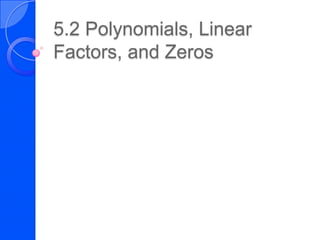
5.2
- 1. 5.2 Polynomials, Linear Factors, and Zeros
- 2. Writing a Polynomial in Factored Form In Chapter 4, we solved quadratic functions by factoring and setting each factor equal to zero We can solve some polynomial functions in a similar way. ◦ Remember: ALWAYS factor out the GCF first!
- 3. Linear Factors, Roots, Zeros, and x-intercepts The following are equivalent statements about a real number b and a polynomial P(x) ◦ (x – b) is a linear factor of the polynomial P(x) ◦ b is a zero of the polynomial function y = P(x) ◦ b is a root (or solution) of the polynomial equation P(x) = 0 ◦ b is an x-intercept of the graph of y = P(x)
- 4. Example: Write each polynomial in factored form. Then, find the zeros of the function.
- 5. Example: Write each polynomial in factored form. Then, find the zeros of the function.
- 6. Graphing a Polynomial Function 1. Find the zeros and plot them 2. Find points between the zeros and plot them 3. Determine the end behavior 4. Sketch the graph
- 7. Example: Find the zeros of the function. Then graph the function.
- 8. Example: Find the zeros of the function. Then graph the function.
- 9. The Factor Theorem The factor theorem describes the relationship between the linear factors of a polynomial and the zeros of a polynomial. The Factor Theorem The expression x – a is a factor of a polynomial if and only if the value a is a zero of the related polynomial function
- 10. Using the Factor Theorem to Write a Polynomial 1. Write each zero as a factor 2. Multiply and combine like terms
- 11. Example: Write a polynomial function in standard form with the given zeros X = –2, 2, and 3
- 12. Example: Write a polynomial function in standard form with the given zeros X = –2, –2, 2 and 3
- 13. Homework P293 #7 – 26, 61 – 63
- 14. Multiple Zeros and Multiplicity A multiple zero is a linear factor that is repeated when the polynomial is factored completely The multiplicity of a zero is the number of times the linear factor is repeated in the factored form of the polynomial. ◦ If a zero is of even multiplicity, then the graph touches the x-axis and “turns around” ◦ If a zero is of odd multiplicity, then the graph crosses the x-axis
- 15. Example: Find the zeros of the function. State the multiplicity of multiple zeros. What does the multiplicity tell you about the graph?